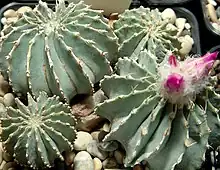Geohintonia
Geohintonia mexicana (discovered in 1992) is a species of cacti, the only species in the genus Geohintonia. This genus is named after its discoverer George S. Hinton. As its specific epithet suggests, the plant is found in Mexico (Nuevo León), where it grows on gypsum hills near Galeana.[1]
| Geohintonia | |
|---|---|
 | |
| Scientific classification | |
| Kingdom: | Plantae |
| Clade: | Tracheophytes |
| Clade: | Angiosperms |
| Clade: | Eudicots |
| Order: | Caryophyllales |
| Family: | Cactaceae |
| Subfamily: | Cactoideae |
| Genus: | Geohintonia |
| Species: | G. mexicana |
| Binomial name | |
| Geohintonia mexicana | |
Description
It is a solitary, globose plant, slowly becoming columnar, up to 10 cm tall and 10 cm in diameter. grayish bluish green. It has between 18 and 20 very prominent ribs, with 3 curved spines about 3 to 12 mm long on each areola. The hot pink, funnel-shaped flowers emerge at the apex and open after dark.
The species has one form: Geohintonia mexicana f. cristata.
 Flower
Flower Geohintonia mexicana f. cristata
Geohintonia mexicana f. cristata
References
- Anderson, Edward F. (2001), The Cactus Family, Pentland, Oregon: Timber Press, ISBN 978-0-88192-498-5, p. 342
External links
 Media related to Geohintonia at Wikimedia Commons
Media related to Geohintonia at Wikimedia Commons Data related to Geohintonia at Wikispecies
Data related to Geohintonia at Wikispecies
This article is issued from Wikipedia. The text is licensed under Creative Commons - Attribution - Sharealike. Additional terms may apply for the media files.